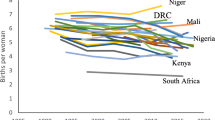Abstract
Studies of fertility behavior in the Third World have relied heavily on two variables, income and education, to explain variations in fertility rates. If the socio-economic variables traditionally employed to account for variations in fertility rates are invariant, what other factors could influence fertility rates and child spacing? On the basis of data from 180 slum households in Calcutta, India, the paper indicates that in a situation where material and social conditions are comparable, cultural and demographic variables play a major role in influencing reproductive behavior. In this case study, caste and family type are shown to have a significant effect on the numbers of surviving children. As regards child spacing, the woman's age is of paramount importance.
Similar content being viewed by others
References
Bebarta, P. C. (1977).Family Type and Fertility in India. Christopher Publishing House, North Quincy, Massachusetts.
Calcutta Corporation Yearbook (1976–1977). Government of West Bengal.
Dyson, T., and Moore, M. (1983). On kinship structure, female autonomy, and demographic behavior in India.Population and Development Review 9(1): 35–60.
Graff, H. J. (1979). Literacy, education and fertility, past and present: A critical review.Population and Development Review 5(1): 105–140.
Jain, A. K., and Nag, M. (1986). Importance of female primary education for fertility reduction in India.Economic and Political Weekly 21: 36.
Kalikata Bustee Pragati Sangstha (KBPS) (1979).Report of a Survey in Selected Micro-Communities. Calcutta.
Lubell, H. (1977). Migration and employment: The case of Calcutta.Social Action 27(3): 279–291.
Mamdani, M. (1972).The Myth of Population Control. Monthly Review Press, New York.
Mamdani, M. (1981). The ideology of population control. In Michaelson, K. L. (ed.),And the Poor Get Children. Monthly Review Press, New York, pp. 39–49.
Mandelbaum, D. G. (1974).Human Feritility in India: Social Components and Policy Perspectives. University of California Press, Berkeley.
Menard, S. (1987). Fertility, development, and family planning, 1970–1980: An analysis of cases weighted by population.Studies in Comparative International Development 22(3): 103–127.
Michaelson, K. L. (1981). Population policy, family size and the reproduction of the labour force in India: The case of Bombay. In Michaelson, K. L. (ed.),And the Poor Get Children. Monthly Review Press, New York, pp. 106–130.
Nag, M. (1983). Modernization affects fertility.Populi 10(1): 56–77.
Pakrasi, K., and Malaker, C. (1967). The relationship between family type and fertility.Milibank Memorial Fund Quarterly 35: 451–460.
Population Council's International Research Awards Program (1981). Research on the determinants of fertility: A note on priorities.Population and Development Review 7(2): 311–324.
Portes, A. (1976). On the sociology of national development: Theories and issues.American Journal of Sociology 82(1): 55–85.
Portes, A. and Walton, J. (1981).Labor, Class and the International System. Academic Press, New York.
Romatet, E. (1981).Calcutta's Informal Sector: Theory and Reality. Mimeo, Paris, France.
Shaw, A. (1984). Wage labour in slum households of Calcutta.Labour, Capital and Society 17(1): 26–42.
Shaw, A. (1985). The informal sector in a third world urban economy: The case of Calcutta, India.Bulletin of Concerned Asian Scholars 17(1): 42–53.
Shaw, A. (1988). The income security fucntion of the rural sector: The case of Calcutta, India.Economic Development and Cultural Change 36(2): 303–314.
Singh, Y. (1977).Modernization of Indian Tradition. Thomson Press, Faridabad, India.
deSouza, A. and Porter, W. (1974).The Underdevelopment and Modernization of the Third World. Association of American Geographers, Washington D.C.
Tata Services Limited.Statistical Outline of India 1986–1987. Department of Economics and Statistics, Bombay.
World Bank (1984).World Development Report 1984. Oxford University Press, New York.
Zachariah, K. C. (1984).The Anomaly of the Fertility Decline in India's Kerala State: A Field Investigation. World Bank Staff Working Papers Number 700, The World Bank, Washington, D.C.
Author information
Authors and Affiliations
Additional information
I would like to thank my colleagues Kevin McHugh and Debashish Bhattacherjee for their critical comments on an earlier draft of this paper.
Rights and permissions
About this article
Cite this article
Shaw, A. Fertility and child spacing among the urban Poor in a Third World city: The case of Calcutta, India. Hum Ecol 16, 329–342 (1988). https://doi.org/10.1007/BF00888450
Issue Date:
DOI: https://doi.org/10.1007/BF00888450




